MXA RACE TEST: 2017 HONDA CRF250 — DEVOID OF DIFFERENCE
Click on images to enlarge
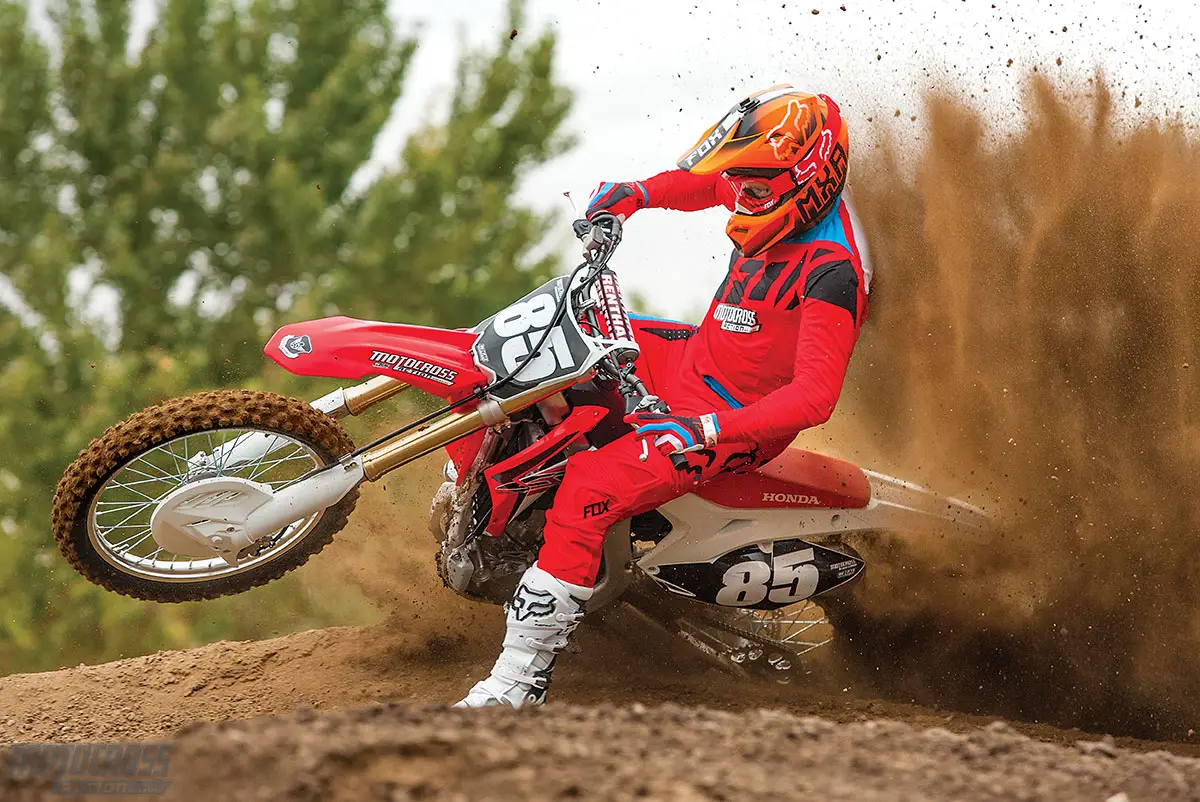
Q: FIRST AND FOREMOST, IS THE 2017 HONDA CRF250 BETTER THAN THE 2016 CRF250?
A: No. Machinery doesn’t get better by stagnating. The 2017 Honda CRF250 is identical to the 2016 model—and we don’t mean identical as in “closely resembling” or “almost exactly the same.” Nope. We mean identical, devoid of difference and indistinguishable.
Q: HOW MANY CHANGES DID HONDA MAKE TO THE 2017 CRF250?
A: How does the number zero sound? If you rolled a 2017 Honda CRF250 and a 2016 Honda CRF250 into Honda’s R&D department and asked Honda’s most brilliant designer to tell the 2017 from the 2016, he couldn’t do it.
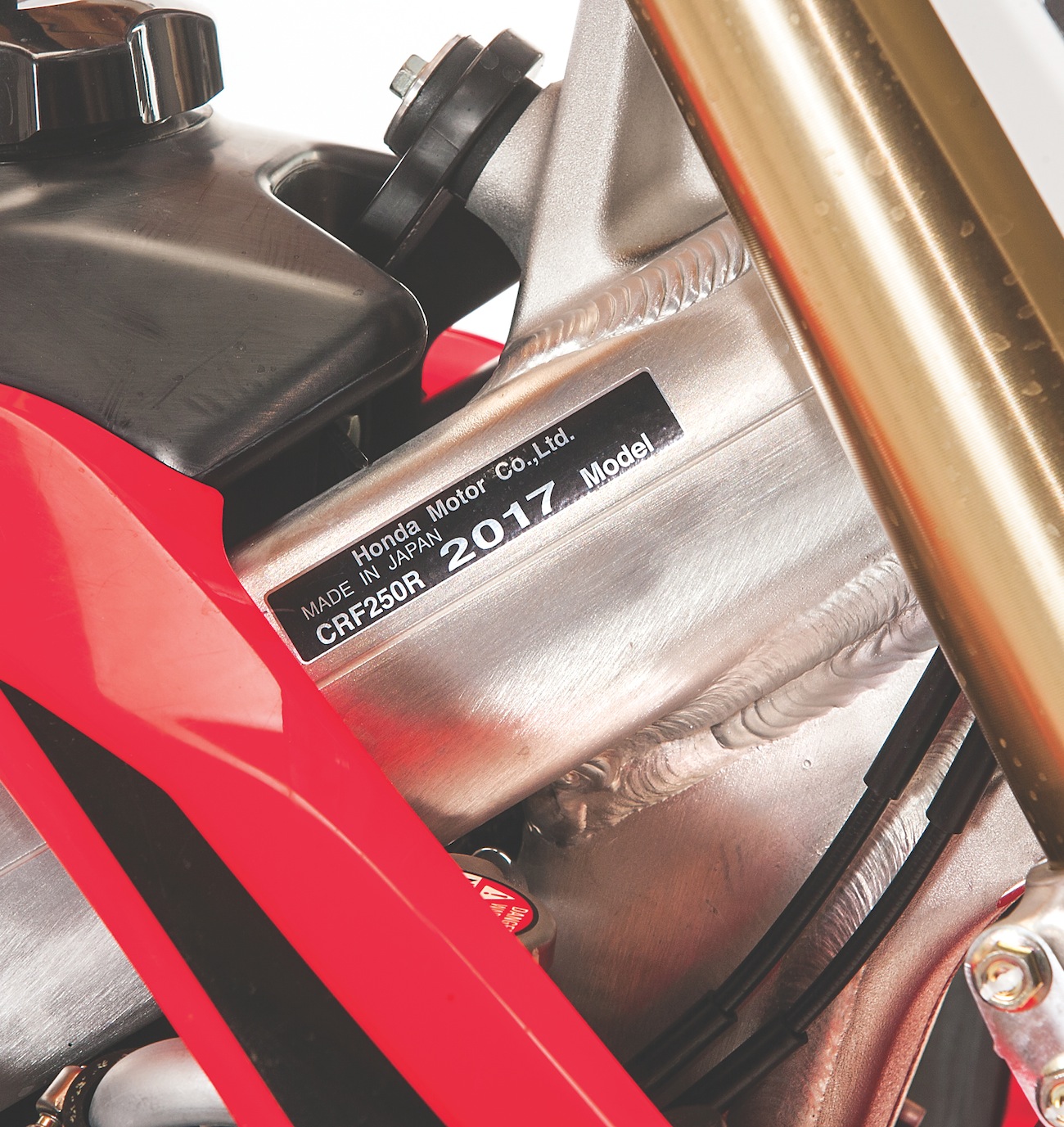 What’s the major difference between last year’s CRF250 and this years? This model I.D. tag. This year it reads “2017” and last year it read “2016.”
What’s the major difference between last year’s CRF250 and this years? This model I.D. tag. This year it reads “2017” and last year it read “2016.”
Q: WHAT CHANGES HAS HONDA MADE TO THE CRF250 OVER THE LAST 10 YEARS?
A: No one can claim that the 2017 Honda CRF250 is anything more than Xerox engineering. But, let’s not paint Honda’s R&D department with the do-nothing brush. Honda has made changes every single year since the CRF250 was first introduced in 2004. Thus, the 2017 Honda is an anomaly. Here is a year-by-year breakdown of the last 10 years of CRF250 updates.
2008 Honda CRF250: For 2008 Honda’s focus was on six changes: First, compression was increased from 12.9:1 to 13.1:1 via a new piston dome. Second, the cylinder head porting and camshaft timing were modified over the 2007 spec, and lighter valve-train components were implemented. Third, the engine’s counter-balancer shaft and gears were reduced in weight to improve throttle response. Fourth, a new black box and exhaust design bumped the rev limiter up 130 rpm (from 13,370 rpm to 13,500 rpm). Fifth, the clutch got stiffer clutch springs and a special judder spring to improve feel. Finally, the CRF250 and CRF450 were equipped with Honda’s HPSD steering damper. Thanks to its 40mm Keihin FCR carb, the 2008 CRF250 made 37.95 horsepower. What you might find surprising is that the Keihin-fueled 2006 CRF250 made the most horsepower of any CRF250 until 2016.
2009 Honda CRF250: For 2009 Honda focused its R&D dollars on the fuel-injected CRF450, not the carbureted CRF250. Changes were limited to a new squish pattern, longer head pipe, four-dog gears instead of 2008’s three dogs, a redesigned shift drum, lighter cauliflower-shaped brake rotors, gray paint on the cylinder head cover, clutch cover and left-side cover and 3mm-longer grips. The CRF250 peaked at 37.02 horsepower, which was the second most horsepower of 2009 behind the KTM 250SXF.
2010 Honda CRF250: The 2010 Honda CRF250 saw the largest number of updates since its inception in 2004. Fuel injection replaced the cranky 40mm Keihin carb. The frame came from the 2009 CRF450, save for the lower frame cradles, lower engine mounts and upper frame casting. Honda upped compression to 13.2:1 with a high-compression piston. Radiator capacity was increased from 1.06 quarts to 1.16 quarts. The Showa forks were upped from 47mm to 48mm (so that Honda could use the same triple clamps as the 48mm Kayaba-equipped CRF450). The CRF250 clutch was Kashima-coated, while the clutch springs were longer and softer. Gearing was changed from 13/51 to 13/48. The twin mufflers were dropped and fuel capacity was reduced from 1.9 gallons to 1.5 gallons (because of the EFI’s fuel pump). The 2010 CRF250 reached 36.37 horsepower.
2011 Honda CRF250: After Honda completely redesigned the 2010 CRF250, the changes for 2011 were limited to a choked-down 94-decibel muffler, a 24mm piston in the HPSD steering damper (up from 20mm), the fuel filter being moved to a vertical position, and the gearing changed for the third year in a row (from 13/51 in 2009 to 13/48 in 2010 to 13/49 for 2011). The 2011 CRF250 reached 37.02 horsepower.
2012 Honda CRF250: For 2012 the CRF250 throttle body was downsized from 50mm to 46mm (same as the 2012 CRF450), while the intake port was downsized to coincide with the 46mm throttle body. On the suspension front, the shock linkage got 4mm-longer pull rods to mate to the new bell crank, while the forks got wider front axle collars to provide more clamping area. Honda also added 7mm-wider footpegs, a 3mm-smaller chain roller and Dunlop MX51 treads. The 2012 CRF250 produced 37.56 horsepower.
2013 Honda CRF250: With Honda spending all of its R&D money on the 2013 CRF450, there was very little money for the CRF250. There were stiffer fork springs and 2mm-larger pistons in the 48mm Showa forks. The shock’s high-speed adjuster-bolt seat diameter was increased from 9.5mm to 11.5mm. For 2013 Honda dropped 2012’s awful Dunlop MX51 front tire for an equally bad Dunlop MX51FA. The 2013 CRF250 powerplant produced 37.19 horsepower.
2014 Honda CRF250: The 2014 Honda CRF250’s main spars were moved down, the subframe reconfigured and the radiators lowered. The 2014 engine got increased compression (13.2:1 to 13.5:1), a forged slipper piston, Dual-Timing Programmed Fuel Injection (one long spritz with a pause in it), wider gears (that were 13 percent stronger), bodywork from the CRF450 and a return to twin mufflers (that had been dropped for 2010). The 2014 CRF250 produced 37.25 ponies.
2015 Honda CRF250: For 2015 the Honda CRF250 got a map switch button, Showa SFF TAC air forks, larger-diameter exhaust, a stiffer shock spring, 260mm front rotor and Dunlop MX52 tires. In 2015 Honda was embracing the “slow and steady wins the race” mantra, which meant that the 2015 CRF250’s horsepower was 37.30.
2016 Honda CRF250: The 2016 CRF250 engine got a lighter piston and connecting rod, titanium exhaust valves, reshaped intake and exhaust ports, an exhaust resonator to the head pipe, increased compression (from 13.5:1 to 13.8:1) and new air-boot shape. Horsepower was upped by 1.6 horses at peak to 38.89 horsepower. The Showa SFF TAC air forks remained the same, but the fork legs were 5mm longer than the 2015 legs. The frame was unchanged, except for anti-mud footpeg scrapers and a 4mm-smaller chain roller.
2017 Honda CRF250: No changes.
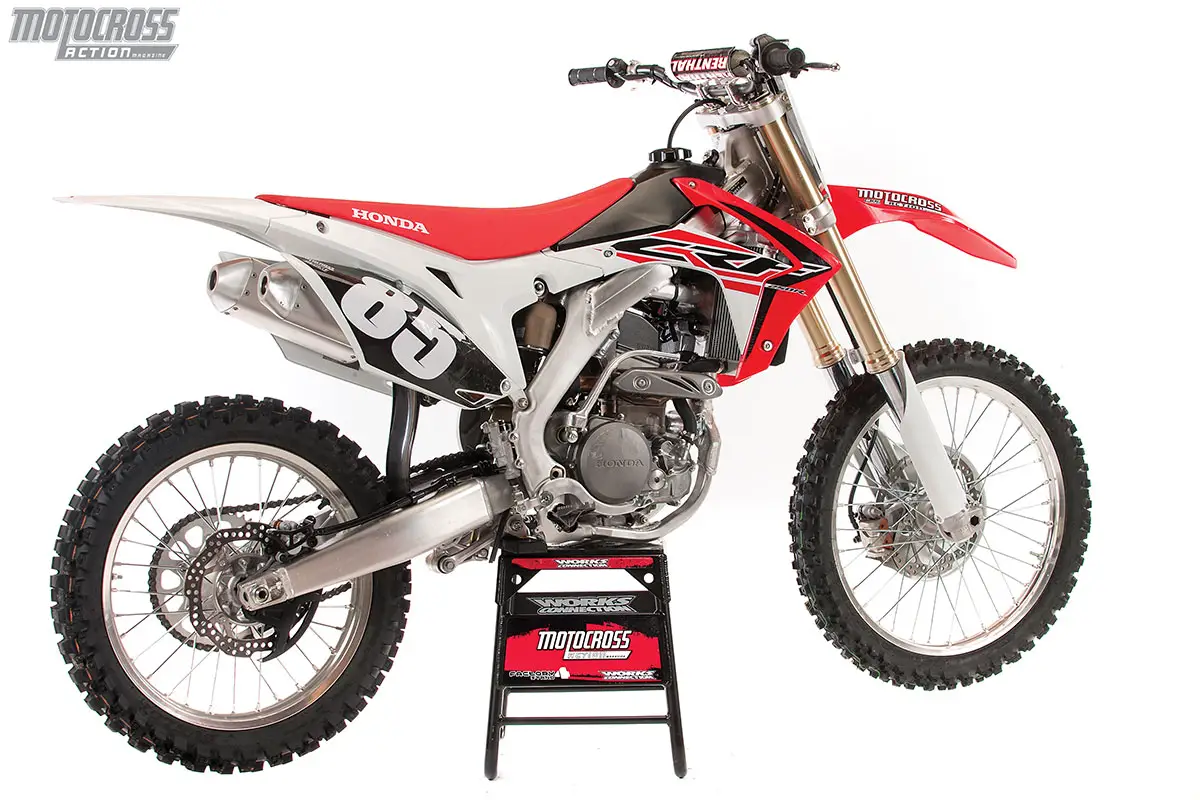
Q: HOW DOES THE 2017 HONDA CRF250 RUN ON THE DYNO?
A: You don’t need Sherlock Holmes to solve this mystery. It runs just like the 2016 CRF250 did. But, that doesn’t help you if you didn’t own last year’s CRF250. So, here is the full skinny. The power on the 2017 Honda CRF250 is a double-edged sword. It is sharp on one side and dull on the other.
The sharp side. The 2016 and 2017 Hondas are the most powerful CRF250s ever. Compared to the 2015 Honda CRF250, the 2016–’17 CRF250 makes 1.6 horsepower more at peak and 2.70 more horsepower at 12,000 rpm, which is after peak. The 38.89 horsepower number sounds good if you limit your scope to a dream-induced Honda-land, but if you step outside of that insular world, the CRF250 is in a world of hurt.
The dull side. Making more horsepower than a Honda CRF250 is not an accolade that any manufacturer should put on its mantle. Honda’s 2017 horsepower numbers were competitive back in 2009, but with the exception of the Suzuki RM-Z250, none of the other manufacturers are living eight years in the past. They have moved on. For example, a 2017 KTM 250SXF matches the Honda’s 38.89 horsepower at 10,600 rpm. And, the KTM isn’t breathing hard at that rpm. Unfortunately for the CRF250, the KTM 250SXF revs to 14,000 rpm, and at 14 grand it is making 43.76 horsepower. That is 5 horsepower more than the CRF250. And, the shocker is that the KTM 250SXF doesn’t make the most horsepower in 2017. The Husqvarna FC250 makes 44.34 horsepower, leaving the CRF250 even farther in the horsepower dust. In dyno terms, the 2017 Husqvarna FC250 (44.34), KTM 250SXF (43.76), Yamaha YZ250F (40.93) and Kawasaki KX250F (40.06) are taking candy from a baby.
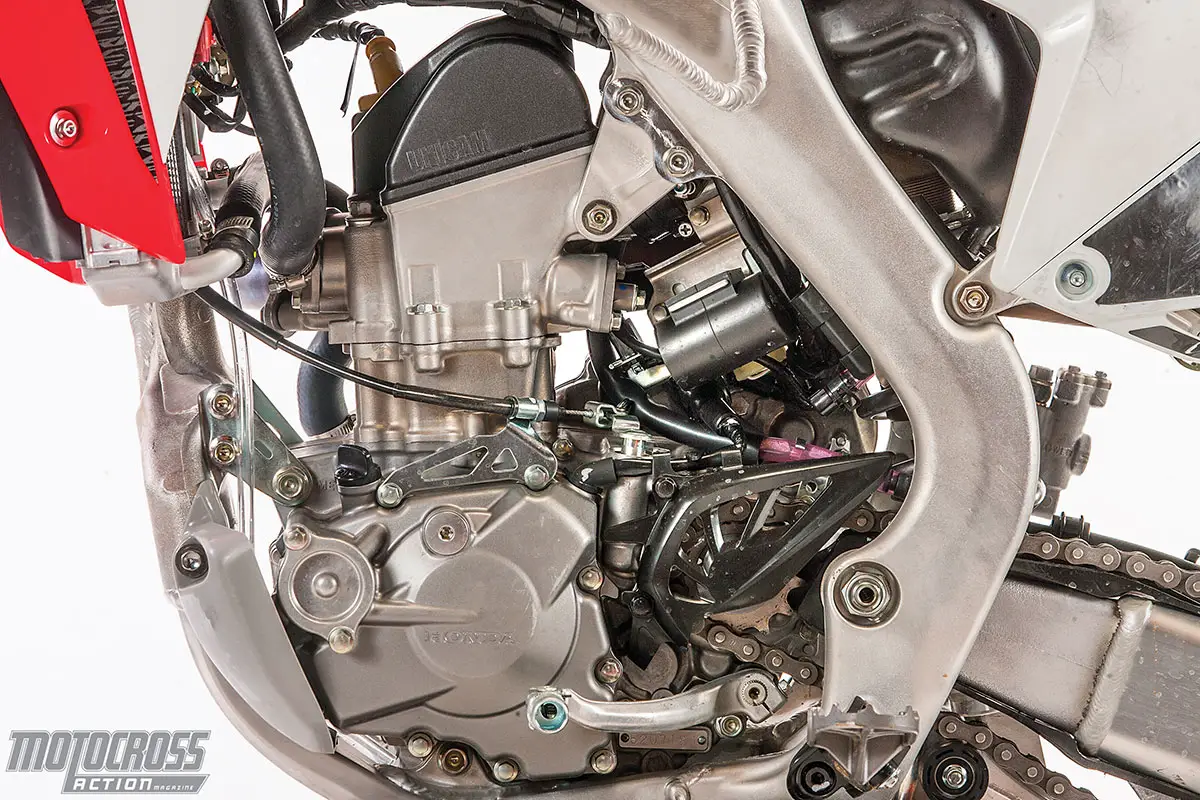
Q: HOW FAST IS THE 2017 HONDA CRF250?
A: We aren’t telling tales out of school to say that this isn’t a modern powerband. It turns over very quickly and runs through its power output in half the time of the stronger and broader engines in the class. You have to shift the CRF250 constantly to stay in the narrow bubble of power. Peak ponies are at 11,700 rpm, while the KTM and Husky peak at 14,000 rpm, the YZ250F at 12,500 rpm and the KX250F at 12,400 rpm. That is the double whammy. The competition not only makes more horsepower, it makes it for a lot longer. This engine is not fighting with Husky, KTM, Kawasaki or Yamaha for first place; it is in a duel of death with the Suzuki RM-Z250 to stay out of last place.
In short, it’s not fast. We don’t feel good about bullying Big Red over its powerband choices, but we would feel worse if an MXA reader bought the CRF250 thinking that it was a player in the power wars. Our job is to point out the good and the bad. We wish that every 2017 test bike were great, but the 2017 CRF250 is an unremarkable machine. It is, however, a decent entry-level race bike in the hands of Beginners and Novices. It has charms that go beyond the dyno chart.
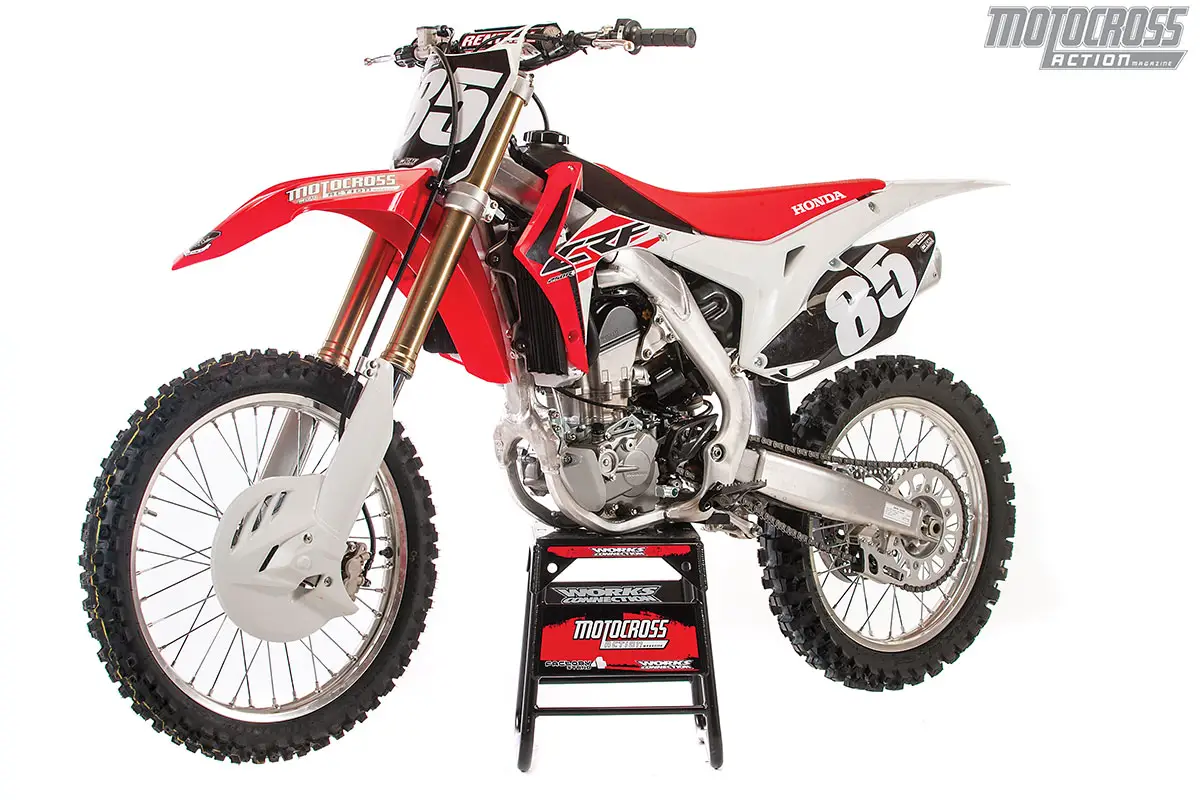
Q: WHAT ARE SOME OF THOSE CHARMS?
A: Here is a quick list of attributes that the MXA wrecking crew likes about the 2017 Honda CRF250.
Handling. Remember up above where we said that Honda lengthened the fork legs by 5mm in 2016? They did that to calm down the chassis, which had gone a little too far into oversteer territory. The 5mm-longer fork legs lifted the head tube, slackened the head angle, moved the weight bias rearward and increased the CRF250’s trail. The result was a calmer chassis at speed and on the entrance to turns. It was the poor man’s frame fix. Every MXA test rider felt at home on the CRF250 chassis. It felt light; it felt right.
Map switch. Honda has three ignition maps that can be selected by pressing a button on the throttle side of the handlebars. Depressing the map button for one second switches the ignition curve to the mellow map. This is distinguishable by two consecutive blinking lights, which repeat three times. Holding the map button down for an additional second switches the ignition curve to the aggressive map. Three lights blink consecutively and repeat three times. Holding down the map button for another second will switch the map back to stock (and a single blue light will flash). Here is a quick rundown on how to choose between the three CRF250 maps.
Known as the “stock” map, map one does nothing exceptionally well. Map two is designed to work best on hard-pack terrain; it is the “mellow” map. It retards the ignition to lessen wheelspin and detunes the engine. We are of the opinion that map two is useless. Why? The Honda CRF250 is already struggling to keep pace with the competition, and it’s not too far a stretch to say that Honda’s stock powerband is comparable to the other brands’ “mellow” maps. MXA testers loathed map number two. Honda’s third map was the unanimous choice among every MXA test rider—from Beginner to Pro.
Suspension. As air forks go, the Honda CRF250 has the best all-around feel of any bike with Showa SFF-TAC forks, followed by the KX450F. The MXA wrecking crew appreciates good forks wherever we find them, and we like Honda’s take on the TAC; however, we believe that the forks are too complex for the typical teenage 250 four-stroke owner to live with. And, we know that Honda feels the same way. How do we know? Because the 2017 Honda CRF450 comes with coil-spring forks based in no small part on consumer studies conducted by Honda themselves.
Ergonomics. The 2017 Honda CRF250 feels comfortable regardless of your stature. The CRF250’s layout in terms of the seat, pegs, bars, levers and pedals is quite pleasing right off the showroom floor. The open cockpit, narrow frame, neutral handlebars and flat seat profile are creature comforts that were well liked by every tester
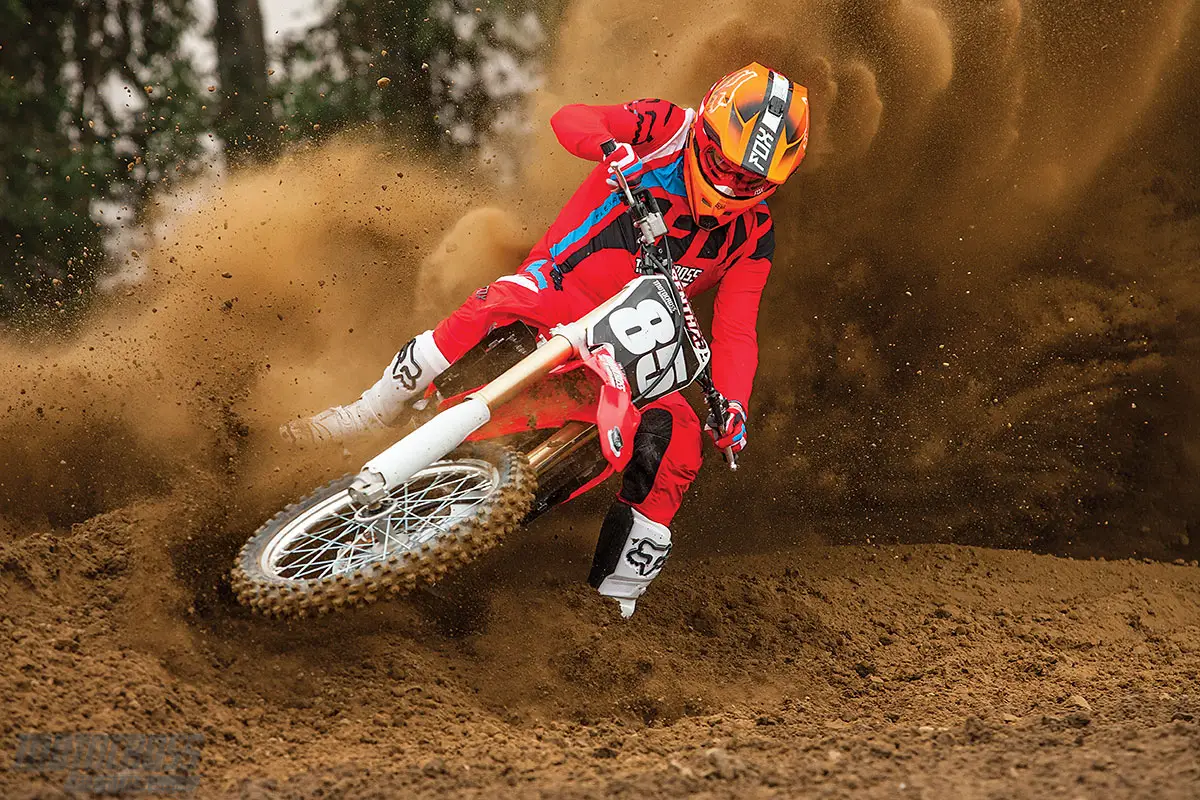
Q: WHAT IS NOT CHARMING ON THE 2017 HONDA CRF250?
A: Here is a quick list of attributes that the MXA wrecking crew doesn’t like on the 2017 Honda CRF250.
(1) Twice pipes. Adding an extraneous muffler to a 250cc four-stroke is ridiculous. Twin pipes were on the CRF250 once before—from 2006 to 2009—before being resurrected in 2014. They don’t make more power, made all the more obvious by the 5-horsepower differential credited to the single muffler on the 2017 KTM 250SXF. They aren’t quieter, especially since Honda has a prescribed sound limit that every production bike must meet regardless of how many mufflers it has. They cost more to replace, repack and repair, while doubling the chance of damage in a crash. If you’re buying an aftermarket pipe for your 2016–’17 CRF250, you’d be smart to look at a single-sided system. It will be $500 cheaper.
(2) Clutch. Honda has been sucking wind in the clutch department for years, but it became more obvious once KTM showed the world how long a clutch could last.
(3) Weight. Things are looking bad when a Honda CRF250 weighs 2 pounds more than a KTM 450SXF. The 224-pound CRF250 hits the scales at 6 pounds heavier than a 2017 KTM 250SXF. Its only saving grace is that it’s lighter than the 226-pound Suzuki RM-Z250. On a related note, Honda would be competitive against Kawasaki and Yamaha if it drop-kicked one muffler and its extra plumbing.
Q: WHAT DID WE HATE?
A: The hate list:
(1) Chain. From whence the phrase “weak link” comes.
(2) Head-shake. When the CRF250 gets twitchy in the rough, it will require your best jazz-hands imitation to keep up with it.
(3) Frame cradle. Imagine a motorcycle that doesn’t sit flat on a stand. The frame cradle is to blame.
(4) Engine. When you see the list of changes that Honda’s engineers made to the 2016 CRF250 engine and the added top end on the dyno chart, you automatically assume that good things will naturally follow on the racetrack. Strangely, they don’t.
(5) Side panels. It’s tough enough to install preprinted numbers on a flat number-plate panel, but two side panels, both with complex curves, defy putting on wrinkle-free number-plate backgrounds. Good luck.
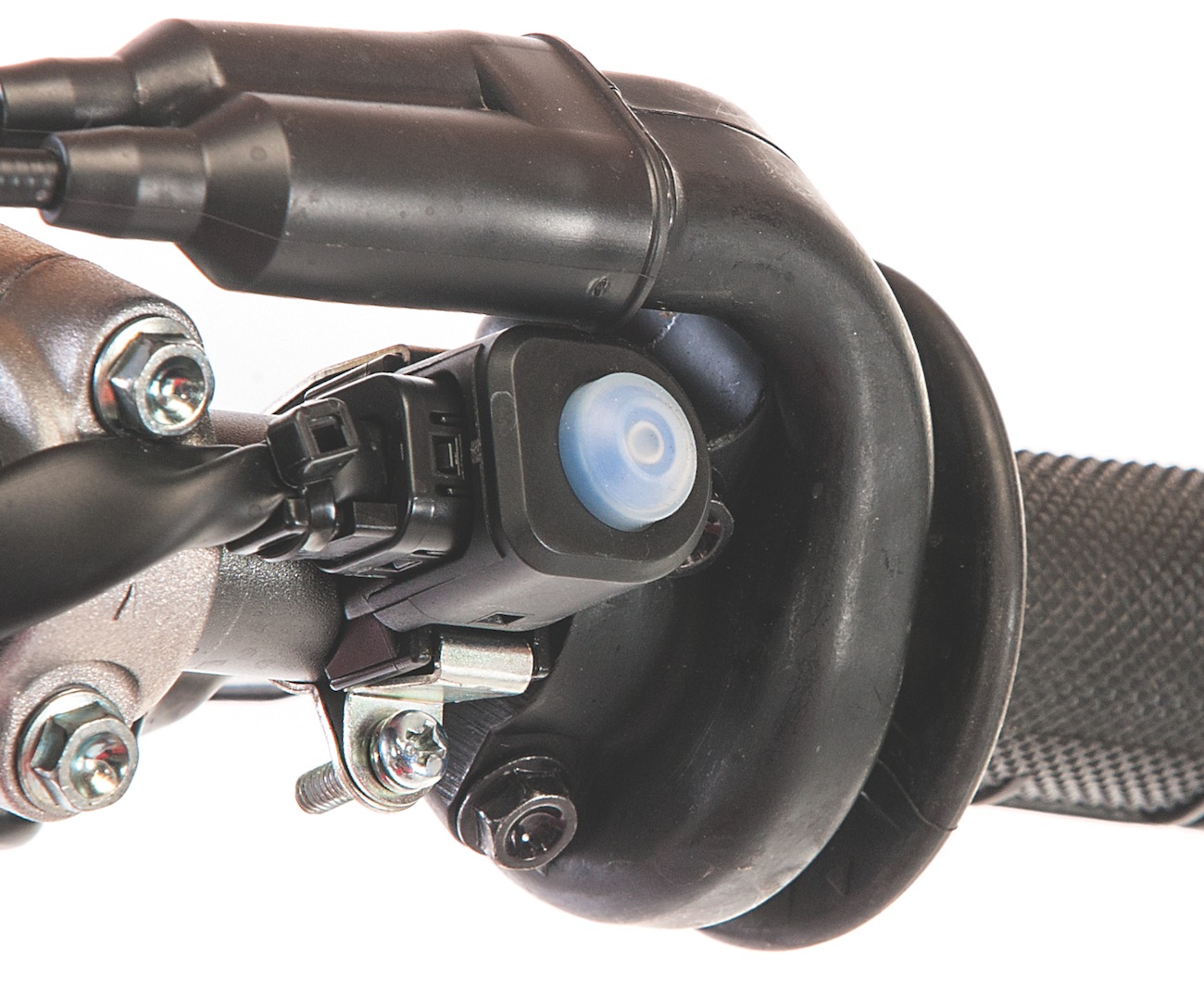 Q: WHAT DID WE LIKE?
Q: WHAT DID WE LIKE?
A: The like list:
(1) Novices. The 2017 Honda CRF250 is at its best in the hands of Beginners and Novices. Obviously, faster riders will either abandon the CRF250 or break out the credit card to buy real power. We suggest not spending money on hopping-up a CRF250, because your bank account isn’t big enough to make it as fast as a KTM is on the showroom floor.
(2) Front brake. At 260mm, it is big, but size isn’t everything. The Honda front brake is not up to the standards set by a KTM brake.
(3) Forks. The only major quibble about the Showa SFF-TAC fork is that the average rider will not fully understand the intricacies of setting and checking multiple air pressures before every ride.
(4) Engine Mode Select. Options are always nice, as are brightly colored flashing lights.
(5) Durability. The CRF250 takes a licking and keeps on ticking.
(6) Steering stem. We go all in on the HPSD steering damper clicker, but don’t be afraid to crank down on the steering-stem nut also. Tighten it until excess slop is gone when applying light pressure to the bars.
Q: WHAT DO WE REALLY THINK?
A: There was a time when Honda owned the motocross market. It didn’t matter what flaws a bike had; if it was red and said “Honda” on the tank, it sold. All that changed in 2009 when Honda replaced the fabled 2008 CRF450 with an ill-conceived set of frame-geometry numbers that must have been drawn out of a hat. Eight years later, Honda’s reputation has yet to recover from that faux pas. The CRF250 went down with the ship because it didn’t gain a single solitary horsepower from 2009 to 2015. And by the time it did up the ponies, it was 5 horses and 6 pounds down to bikes with better brakes, stronger clutches and electric starters.
MXA’S HONDA CRF250 SETUP SPECS
This is how we set up our 2017 Honda CRF250 for racing. We offer it as a guide to help you get your own bike dialed in.
SHOWA SFF-TAC FORK SETTINGS
When SFF-TAC forks first appeared on the CRF250, the owner’s manual suggested 174 psi in the inner chamber, 170 psi in the balance chamber, and they didn’t even include a Schrader valve for the outer chamber. For 2017 they recommend 156 psi in the inner and balance chambers and 8 psi in the outer chamber. These new numbers are right in the ballpark. Our test bike came with a sticker on the left fork leg that listed the recommended air pressures. But, more important, the sticker had a glyph that must be used to determine which air pressure goes where. Without the pictogram-style glyph, you will most likely put 156 psi in the Schrader valve that requires 12 psi. For hardcore racing, these are MXA’s recommended 2017 Honda CRF250 fork settings (stock settings are in parentheses):
Inner chamber: 156 psi
Outer chamber: 8 psi (12 psi)
Balance chamber: 156 psi
Compression: 6 clicks out
Rebound: 18 clicks out (24 clicks out)
Fork-leg height: Flush with top clamp
Notes: Focus on getting the air pressure dialed in for your weight and track. Leave the clickers in the stock positions until you have the perfect spring rate, then move on to the clickers. Don’t obsess over the air pressure.
SHOWA PRO-LINK SHOCK SETTINGS
Here is what the MXA wrecking crew ran in its 2017 CRF250 (stock settings are in parentheses):
Spring rate: 5.3 kg/mm
Race sag: 105mm
Hi-compression: 2-3/4 turns out (3 turns out)
Lo-compression: 10 clicks out
Rebound: 6 clicks out (8 clicks out)
Notes: The shock is very sensitive to high-speed compression. Every rider should go in 1/4 turn on the high-speed compression. Heavier riders should set the sag at 100mm instead of 105mm.
MXA’S FIRST RIDE! 2017 HONDA CRF250


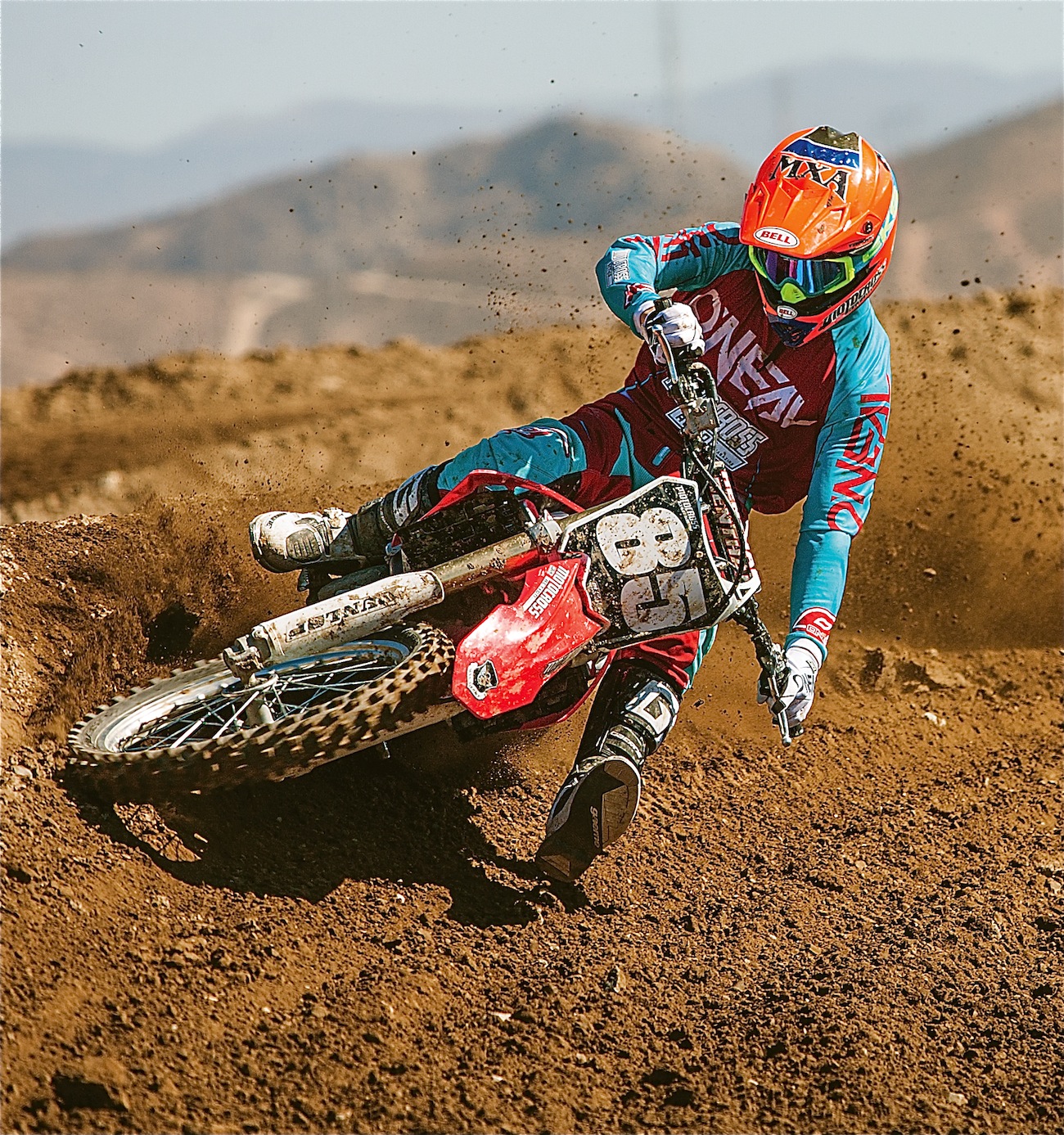

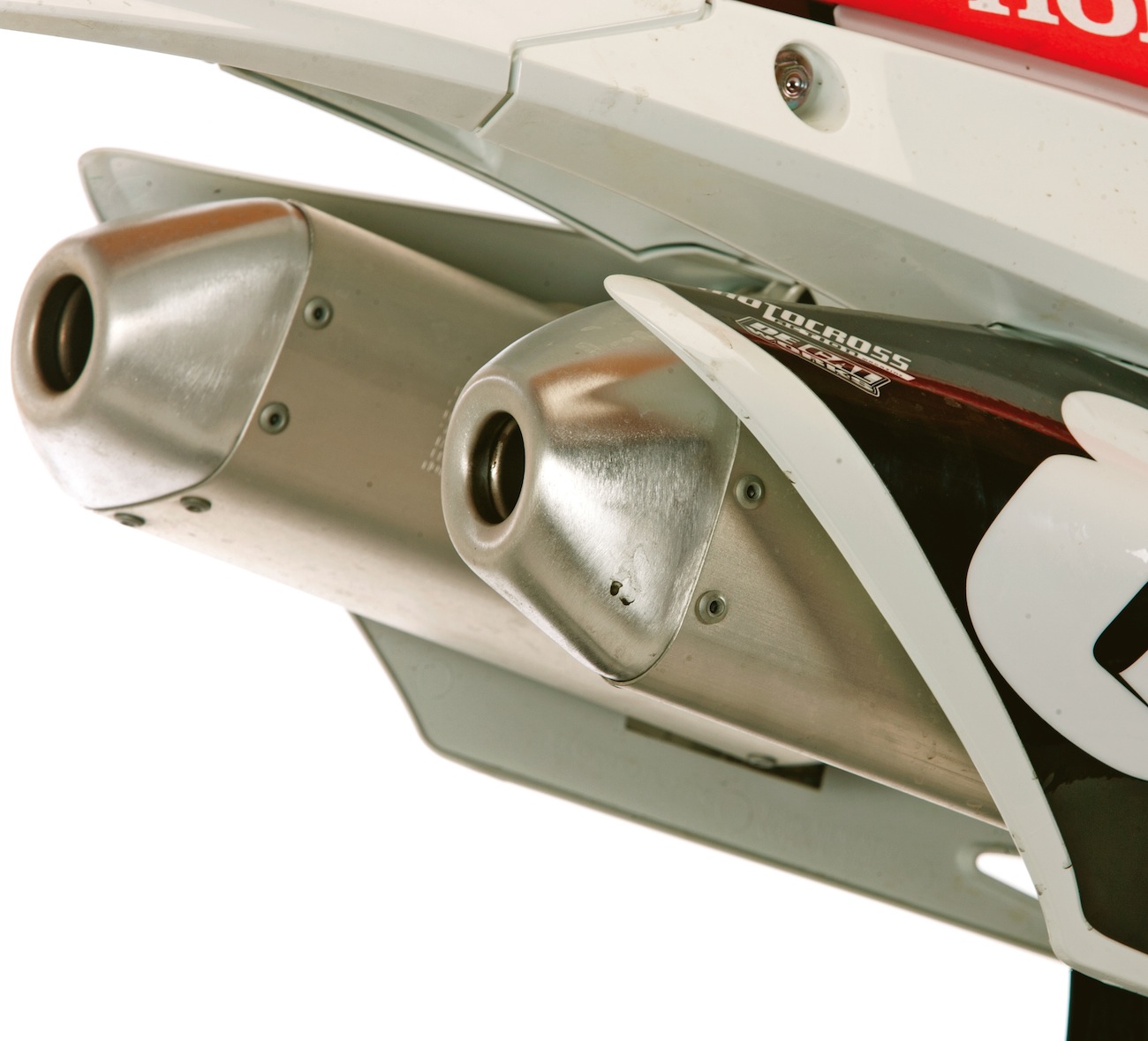
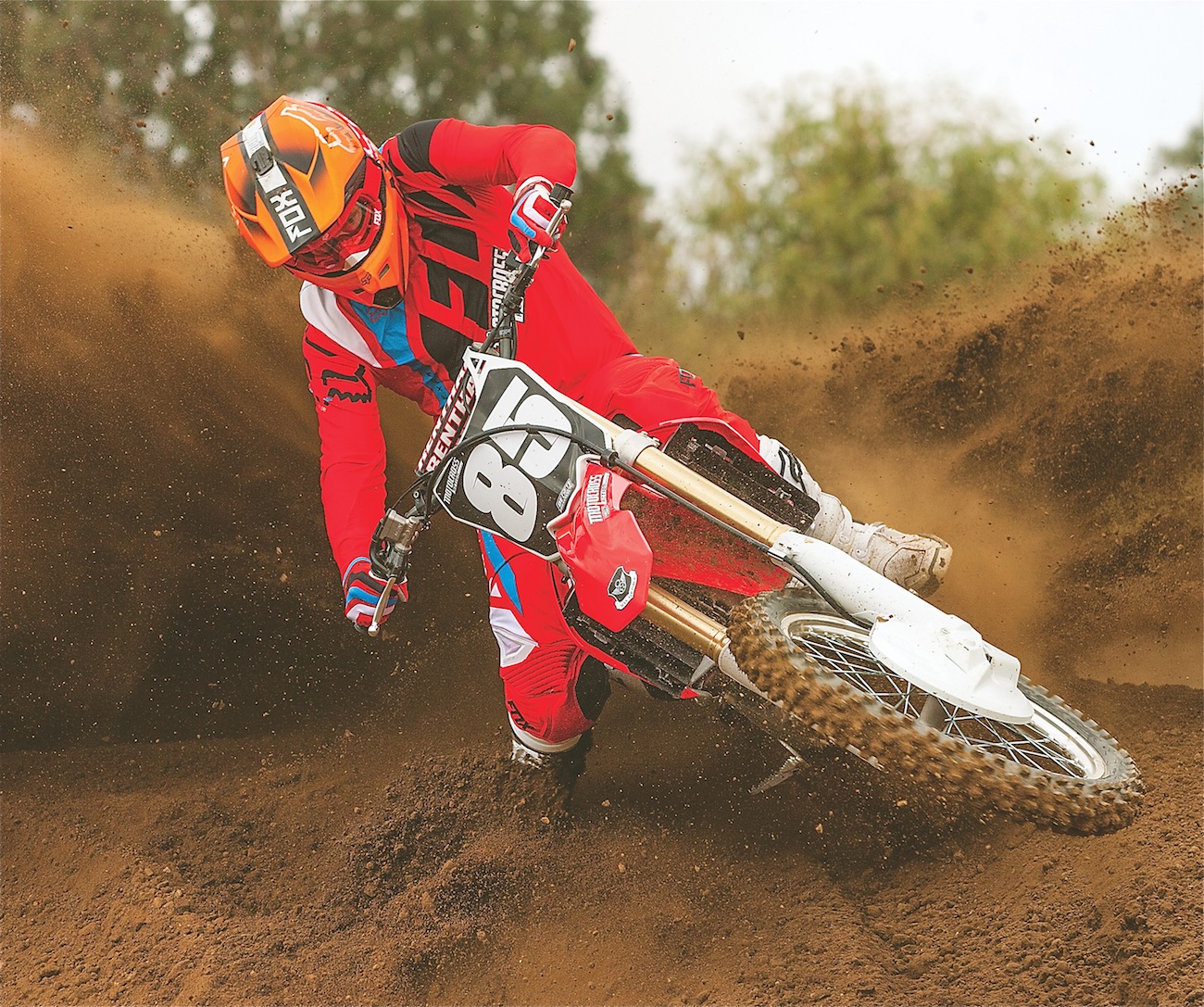
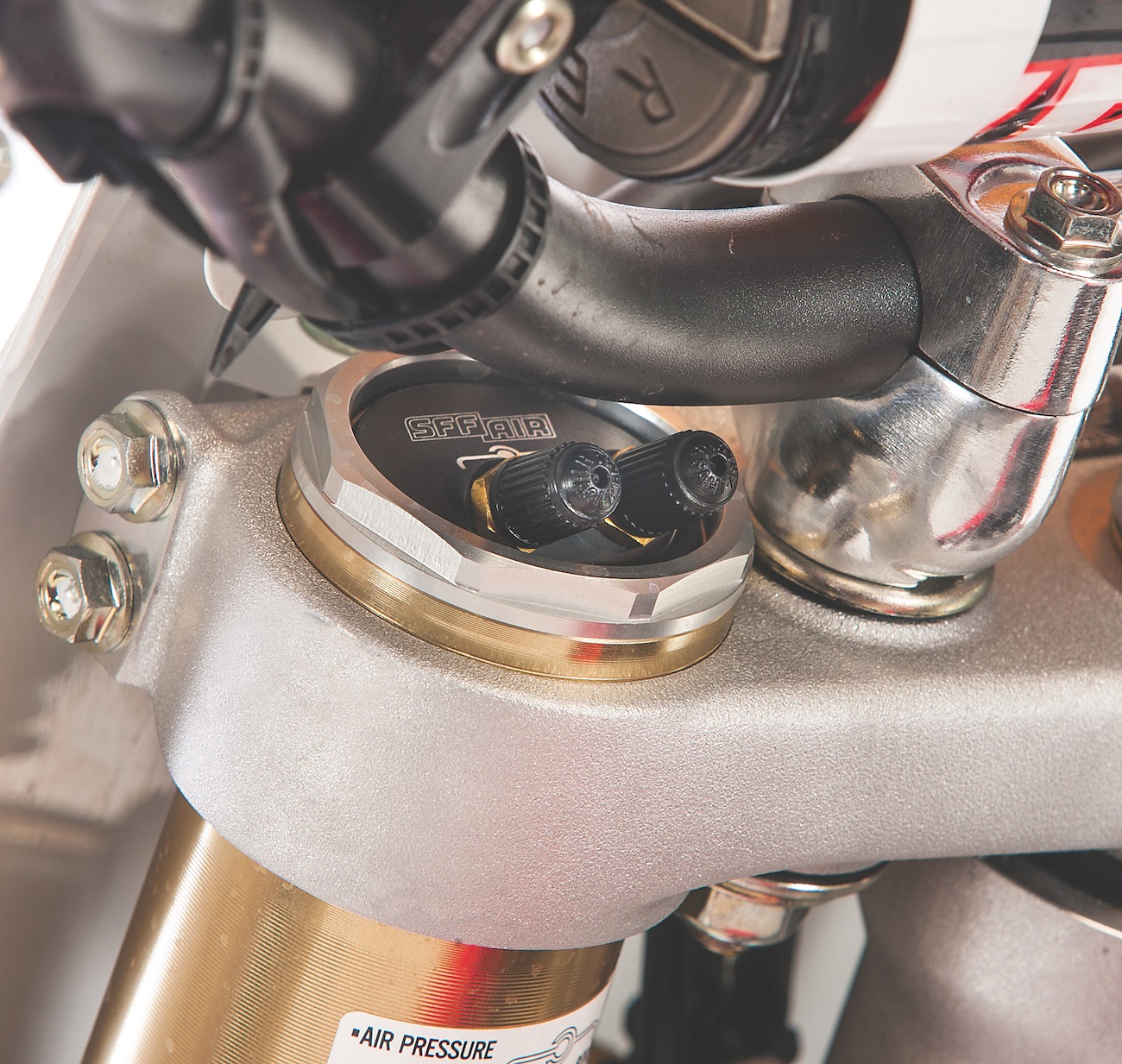




Comments are closed.